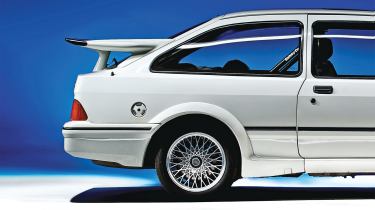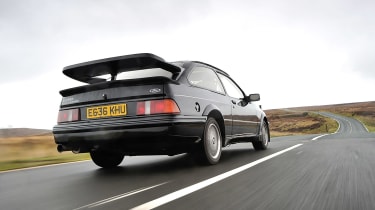Ford Sierra RS Cosworth whale tail - Art of Speed
The Sierra RS Cosworth's bold whale tail didn't impress the higher-ups, but it made it to production nevertheless
Before the original Ford Sierra RS Cosworth was launched in 1985, the term ‘whale tail’ was commonly associated with Porsche’s 911 Turbo, appropriately describing a rear spoiler of outsized proportions conspicuous enough to be a talking point in itself. Who would ever have believed that a humble three-door Ford Sierra would have the nerve to trump it?
But then the original Ford ‘Cossie’ was a revelation in every sense and, for some, invented the idea of a supercar for the common man. Like many a good surprise, it resulted from a chance conversation. Disappointed with the Blue Oval’s poor results in touring car racing in the early ’80s, Ford motorsport boss Stuart Turner suggested putting an experimental turbocharged 16-valve 2-litre Pinto motor, breathed on by Cosworth, in the slow-selling three-door Sierra.
> Ford Sierra RS Cosworth – review, history, prices and specs
After all, it was rear-drive and, compared to most of the competition, had a fairly slippery shape. It would be good for Ford’s racing ambitions and, with a run of 5000 road-going Cosworths for Group A homologation, good for the Sierra. Lothar Pinske of Ford’s Special Vehicle Engineering division was responsible for the modifications to the Sierra’s bodywork and decreed that there were to be no half measures when it came to keeping the car pinned to the road. Only too aware that the Sierra’s hatchback body suffered significant aerodynamic lift even at moderate speed, he insisted that a big rear wing was the only answer.
After prolonged wind-tunnel testing and test runs at the Nardò circuit in Italy, a prototype based on an XR4i bodyshell with the necessary aero addenda fashioned from fibreglass and aluminium was presented to the management. The management wasn’t impressed, the huge rear wing in particular attracting the most censure. But Pinske was resolute, insisting that the wing was essential to retain ground contact at the 185mph the racers would be capable of. Tension persisted but, eventually, the Ford designers were given the go-ahead to make a production version based on the prototype.
The whale tail that appeared on the production Cosworth supplied a modest 20 kilos or so of downforce at 70mph, a deliberate softening of the set-up for the racers, though Pinske would have preferred a little more. His wish was subsequently granted with the more powerful RS500, which had a Gurney flap on the trailing edge of the whale tale and an additional lip spoiler at the back of the tailgate, a combination that produced closer to 100kg of downforce at 100mph.
The next ‘Cossie’, based on the Sierra Sapphire saloon and with four-wheel drive, may have been a ‘safer’, stealthier steer, but few gave it a second glance.




